M
I
C
R
O
S
T
O
R
Y
O
F
A
R
T
........................................................

NOW COMPLETED:

........................................................
MICROSTORY OF ART
ONLINE JOURNAL FOR ART, CONNOISSEURSHIP
AND CULTURAL JOURNALISM
........................................................
INDEX | PINBOARD | MICROSTORIES |
FEATURES | SPECIAL EDITIONS |
HISTORY AND THEORY OF ATTRIBUTION |
ETHNOGRAPHY OF CONNOISSEURSHIP |
SEARCH

........................................................



 >MICROSTORIES
>MICROSTORIES
- Richard Serra
- Martin Scorsese
- Claude Simon
- Sunshine
- Werner Herzog
- The Creation
- Marcel Duchamp
- Nino Rota
- Wölfflin and Woolf
- Hansjörg Schneider
- Kraftort Arkadien
- Visual Biography
- Schlaraffenleben
- Die Geisteswissenschaften
- The Voyeur
- Buzzword Sustainability
- Paul Verlaine
- Tao Yuanming
- New Beginning
- Seneca
- Still Lifes
- Charles Baudelaire
- Frédéric Chopin
- The Art History of Sustainability
- Wang Wei
- Solarpunk
- Historians of Light
- Lepanto
- Renaturalization
- Plates
- Snow in Provence
- Learning to See
- Picasso Dictionaries
- Peach Blossom Spring
- Picasso Tourism
- Tipping Points
- Sviatoslav Richter
- Weather Reports
- Treasure Hunt
- Another Snowscape in Picasso
- Picasso in 2023
- Dragon Veins
- The Gloomy Day
- The Art of the Pentimento
- Reforestation
- The Status of Painting
- Emergency Supply
- Punctuality
- Watching Traffic
- Zhong Kui
- How Painting Survived the 1990s
- Confirmation Bias
- Sustainability and Luxury
- Garage Bands
- Picasso and Artificial Intelligence
- Eyes of Tomorrow
- Picasso in 2023 2
- Gluing Oneself to Something
- Suburbia
- Bamboo
- Sustainability and Carpe Diem 1
- Interviews with Bruegel
- Sustainability and Carpe Diem 2
- Coffee & Sugar
- Bamboo 2
- Picasso in 2023 3
- Sustainability and Carpe Diem 3
- Cherry Orchard
- Old Magazines
- Chance
- Nick Drake
- Harlequin
- The Smartphone & the Art Book
- Atlas Syndrome
- The Kitchen
- Atlas Syndrome 2
- Consideration
- Tori Amos
- School
- Orchard Auctioning Day
- The Hundred Years’ War
- Sócrates
- Chameleon
- Nefertiti Bust
- Picasso as a Computer
- Sunflowers
- Philemon & Baucis
- Ode to the Radio
- Childhood
- Wimmelbild
- Restitution
- Nick Drake 2
- Wishful Thinking
- Sundays
- The Independent Scholar
- September
- The Fisherman by Pirosmani
- Microadventure
- Sociology
- Salvator Mundi
- Chillon
- Appassionata
- Amber
- Homer
- Berlin
- Planet Walk
- Improvisation
- Seeing Picasso
- These Nice Kids
- Robber
- The One
- The Sea Turtle
- Zoo
- Through the Hush
- Wunderkammer
- I Do Not Seek, I Find
- Shopping Mall
- Food Hamper
- The Secretary
- This Gate
- Nor Rainy Day
- House on a Hill
- Beautiful Island
- Second-hand Bookstore
- Flat
- Slap in the Face
- Serra, Wenkenpark
- Apologies
- The Bells
- Nordmann Fir
- Picasso Wanting To Be Poor
- Picasso, Pirosmani
- A Brief History of Sculpture
- 24 Sunsets
- Rusty Phoenix
- Glove
- Wintry Stanza
- A Song
- Like A Beatle
- Catching An Orange
- Solar Bees
- Permaculture

 >FEATURES
>FEATURES
- Van Gogh On Connoisseurship
- Two Museum’s Men
- Ende Pintrix and the City in Flames
- Titian, Leonardo and the Blue Hour
- The Man with the Golden Helmet: a documentation
- Un Jury d’admission à l’expertise
- Learning to See in Hitler’s Munich
- Leonardo da Vinci and Switzerland
- The Blue Hour Continued
- The Blue Hour in Louis Malle
- Kafka in the Blue Hour
- Blue Matisse
- Blue Hours of Hamburg and LA
- A Brief History of the Cranberry
- The Other Liberale in the House
- The Blue Hour in Raphael
- Who Did Invent the Blue Hour?
- Monet on Sustainability
- Velázquez and Sustainability
- The Blue Hour in Guillaume Apollinaire
- Van Gogh on Sustainability
- The Blue Hour in Marcel Proust
- Picasso and Sustainability
- The Contemporary Blue Hour
- The Blue Hour in 1492
- The Blue Hour in Hopper and Rothko
- Hopper and Sustainability
- The Blue Hour in Ecotopia
- The Hour Blue in Joan Mitchell
- Explaining the Twilight
- The Twilight of Thaw
- The Blue Hour in Pierre Bonnard
- Explaining the Twilight 2
- Picasso on Stalin
- Rubens on Sustainability
- The Salvator Mundi in Bruegel and Rubens
- The Blue Hour in Leonardo da Vinci and Poussin
- The Blue Hour in Rimbaud
- Faking the Dawn
- Frost and Thaw in Ilya Ehrenburg
- Picasso, Stalin, Beria
- Picasso, Solzhenitsyn and the Gulag
- Shostakovich on Picasso
- Hélène Parmelin in 1956
- Historians of Picasso Blue
- Picasso Travelling to Moscow 1
- The Blue Hour in Caravaggio
- Picasso Travelling to Moscow 2
- Picasso, the Knife Game and the Unsettling in Art
- Some Notes on Leonardo da Vinci and Slavery
- Picasso Moving to the Swiss Goldcoast
- The Blue Hour in Camus
- The Blue Hour in Symbolism and Surrealism
- Caspar David Friedrich in His Element
- Exhibiting the Northern Light
- Caspar David Friedrich in His Element 2
- Robert Schumann and the History of the Nocturne
- The Blue Hour in Robert Schumann
- Caspar David Friedrich and Sustainability
- The Twilight of Thaw 2
- Multicultural Twilight
- The Blue Hour in Anton Chekhov
- The Blue Hour in Medieval Art
- Twilight Photography
- The Blue Hour in Bob Dylan
- Iconography of Optimism

 >SPECIAL EDITIONS
>SPECIAL EDITIONS
- Visions of Cosmopolis
- Mona Lisa Landscapes
- Turner and Ruskin at Rheinfelden
- Painters On TV & On TV
- Spazzacamini in Art
- A Last Glance at Le Jardin de Daubigny
- The Experimental Cicerone
- A Dictionary of Imaginary Art Historical Works
- Iconography of Blogging
- Begegnung auf dem Münsterplatz
- Cecom
- Das Projekt Visual Apprenticeship
- Those Who See More
- A Fox on Seeing with the Heart
- Sammlung Werner Weisbach
- Daubigny Revisited
- Some Salvator Mundi Microstories
- Some Salvator Mundi Afterthougths
- Some Salvator Mundi Variations
- Some Salvator Mundi Revisions
- A Salvator Mundi Questionnaire
- A Salvator Mundi Puzzle
- Unknown Melzi
- Francis I and the Crown of Charlemagne
- From Amboise to Fontainebleau
- Drones Above Chambord
- Looking Back At Conques
- Flaubert At Fontainebleau
- Images of Imperial Ideology
- The Chronicles of Santa Maria delle Grazie
- Seeing Right Through Someone
- Melzi the Secretary
- Eying Glass
- A Foil to the Mona Lisa
- A Renaissance of the Cartoon
- Sketching a Family Tree
- Venetian Variations
- A Brief History of Digital Restoring
- A Consortium of Painters
- Leonardeschi and Landscape
- A Christ in Profile
- Learning to See in Spanish Milan
- A History of Gestures
- Leonardo and Josquin
- A Renaissance of the Hybrid
- Suida and Heydenreich
- The Watershed
- Three Veils
- From Beginning to End
- Connoisseurship of AI
- Twilight and Enlightenment
- The Blue Hour in Chinese Painting
- Dusk and Dawn at La Californie
- Iconography of Sustainability
- The Blue Hour in Goethe and Stendhal
- The Sky in Verlaine
- The Blue Hour in Paul Klee
- Iconography of Sustainability 2
- The Blue Hour in Charles Baudelaire
- From Bruegel to Solarpunk
- Some Salvator Mundi Documentaries
- Some More Salvator Mundi Monkey Business
- The Windsor Sleeve
- Brigitte Bardot’s Encounter with Picasso
- Art Historians and Historians
- A Salvator Mundi Chronicle
- The Salvator Mundi and the French Revolution
- The Fontainebleau Group
- The Encounter of Harry Truman with Pablo Picasso
- The Fontainebleau Group Continued
- The Windsor Sleeve Continued
- The Salvator Mundi in Early Netherlandish Painting 1
- Some Salvator Mundi Resources
- A New Salvator Mundi Questionnaire
- The Woman in Picasso
- The Yarborough Group
- Melzi, Figino and the Mona Lisa
- The Yarborough Group Continued
- A Salvator Mundi Global History
- The Salvator Mundi in Medieval Art
- The Salvator Mundi in Medieval Art 2
- The Salvator Mundi in Early Netherlandish Painting 2


 >HISTORY AND THEORY OF ATTRIBUTION
>HISTORY AND THEORY OF ATTRIBUTION
- The Mysterious »Donna Laura Minghetti-Leonardo«
- Assorted Demons of Connoisseurship
- Panofsky Meets Morelli
- Discovering the Eye of Sherlock Holmes
- Handling the Left-handed Hatchings Argument
- Visual History of Connoisseurship
- Alexander Perrig
- Connoisseurship in 2666
- What Postmodernity Has Done to Connoisseurship
- Dividing Four Fab Hands
- A Leonardesque Ambassador
- Test Cases in Connoisseurship
- A Raphael Expertise
- How to Tell Titian from Giorgione
- Louise Richter
- The Unique Property in the History of Connoisseurship
- An Expertise by Berenson
- The Book of Expertises
- An Album of Expertises
- An Expertise by Friedländer
- A Salvator Mundi Provenance
- How to Tell Leonardo from Luini
- An Expertise by Crowe and Cavalcaselle
- An Expertise by Bayersdorfer
- An Expertise by Hermann Voss
- An Expertise by Hofstede de Groot
- Leonardeschi Gold Rush
- An Unknown »Vermeer«
- An Expertise by Roberto Longhi
- An Expertise by Federico Zeri
- A Salvator Mundi Geography
- A Salvator Mundi Atlas
- The Bias of Superficiality
- 32 Ways of Looking at a Puzzle
- James Cahill versus Zhang Daqian
- Five Fallacies in Attribution
- On Why Art History Cannot Be Outsourced to Art Dealers
- On Why Artificial Intelligence Has No Place in Connoisseurship
- Salvator Mundi Scholarship in 2016
- Leonardo da Vinci at the Courts
- The Story of the Lost Axe
- The Last Bruegel
- A Titian Questionnaire
- On Where and Why the Salvator Mundi Authentication Did Fail
- The Problem of Deattribution

 >ETHNOGRAPHY OF CONNOISSEURSHIP
>ETHNOGRAPHY OF CONNOISSEURSHIP
MICROSTORY OF ART
ONLINE JOURNAL FOR ART, CONNOISSEURSHIP
AND CULTURAL JOURNALISM
........................................................

***
ARCHIVE AND FURTHER PROJECTS

1) PRINT


***
2) E-PRODUCTIONS


........................................................

........................................................

........................................................
FORTHCOMING:


***
3) VARIA

........................................................

........................................................

........................................................

........................................................

........................................................
***
THE GIOVANNI MORELLI MONOGRAPH

- The Giovanni Morelli Monograph
........................................................
MICROSTORY OF ART
ONLINE JOURNAL FOR ART, CONNOISSEURSHIP AND CULTURAL JOURNALISM
HOME
MICROSTORY OF ART ONLINE JOURNAL FOR ART, CONNOISSEURSHIP AND CULTURAL JOURNALISM From Amboise to Fontainebleau |
See also the episodes 1 to 3 of our New Salvator Mundi History:
Francis I and the Crown of Charlemagne
And:
From Amboise to Fontainebleau

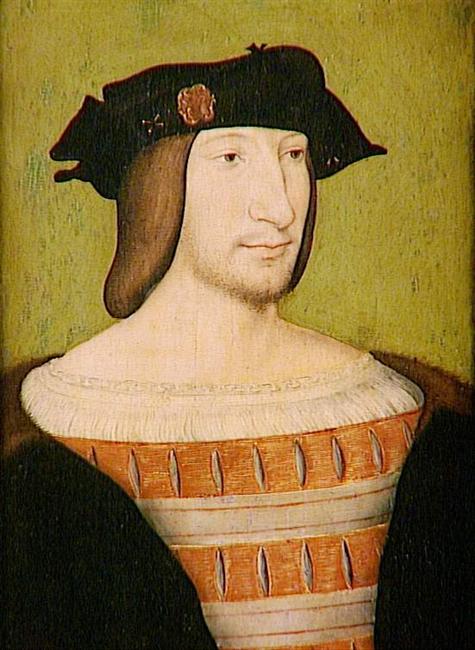
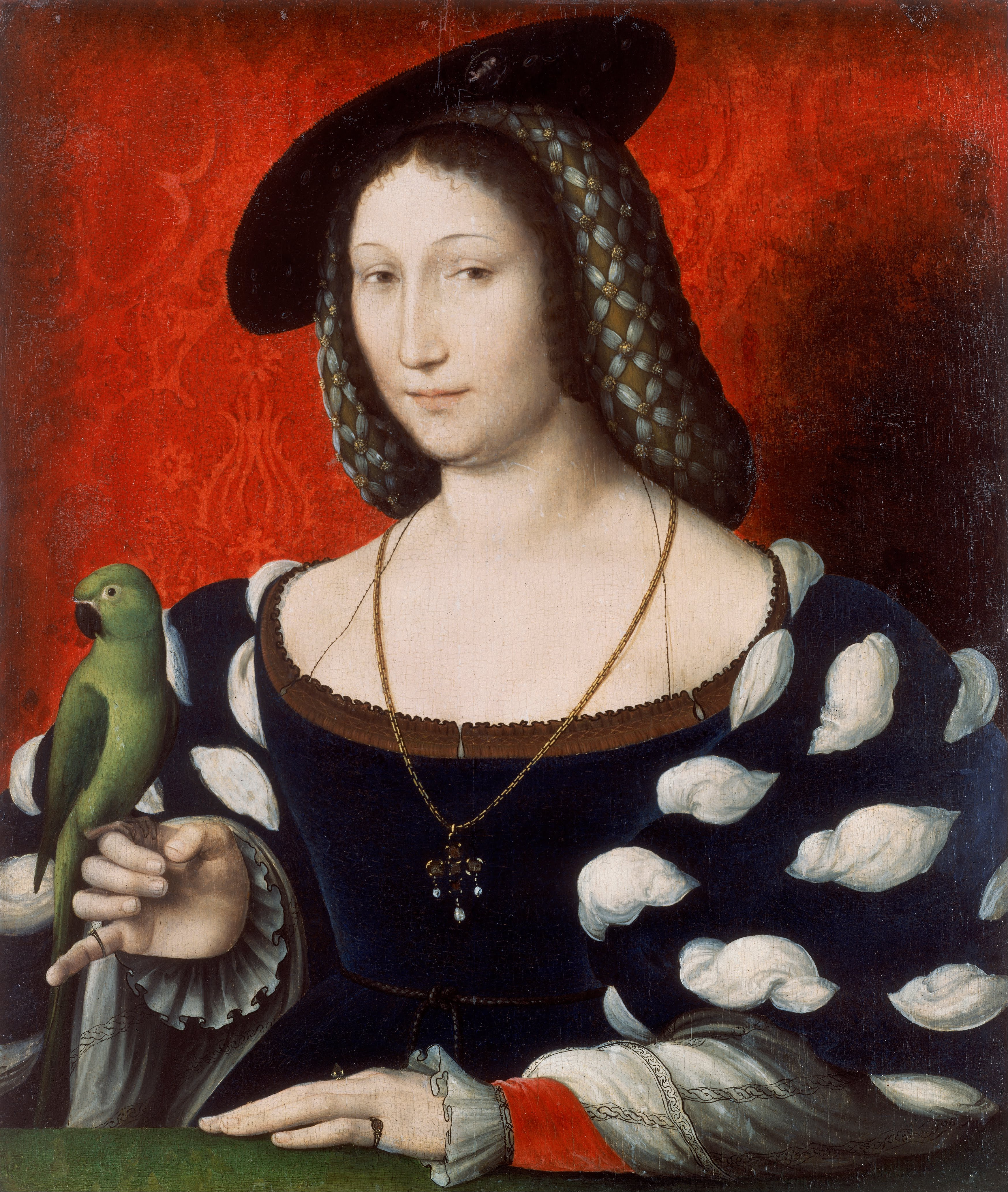
(28.-29.6.2021) Here comes the fourth episode of our New Salvator Mundi History. We had seen that the period of
Leonardo da Vinci staying in France is exactly coinciding with the French king Francis I’s campaign for the
imperial crown. One should not be mistaken that this campaign was the king’s spontaneous idea in 1519: in fact
it is rather obvious from Raphael’s fresco in the Vatican (showing Leo X crowning Francis I, if disguised in
historical costume) that the king pursued this idea for years, namely for the years 1516 to 1519. His campaign even
involved the president of the Parlement (see Knecht, p. 194), and documents show also that as early as in 1518 Francis I
authorized large sums to be offered to the electors to get their votes (emperor Maximilian I was still alive at
this time).
One might also add that at least one art historian (Manfred Franz) thinks that the castle of Chambord (begun in 1519)
was meant to symbolize exactly this aspiration: of becoming the emperor of the Holy Roman Empire (and if this is true,
the castle of Chambord would also belong into our picture of a Salvator Mundi picture being produced
at Clos Lucé/Amboise, a picture that, as far the orb is concerned, corresponds with the imperial insignium in the Charlemagne
depiction in the Parlement of Paris: we would see Leonardo being involved, directly or indirectly, in two projects
that can be linked to the campaign for the imperial crown.
We should stress that the corresponding of the two orbs does not make sense for a period earlier than 1516
(and in my view all the corresponding hypotheses as to authorship and dating of the picture are rather obsolete);
and certainly it did make even less sense after the failure of the campaign to remind or to be reminded of this
corresponding (and we had accepted this as a possible explanation of why the picture, seemingly, has not enjoyed a more
prominent status in the French royal collection in the first half of the 16th century). As we will point out more in
detail it does also make little sense to assume that Francis I acquired this Salvator Mundi from Salaì’s estate after 1525
(only to have it ›embellished‹ with a green background in the Valois court style?). In fact we see a number of reasons
for this idea to be dropped (see below), which means that the Salvator Mundi version Cook was not among Salaì’s
belongings (as also the Louvre is assuming). The question is: are we willing to see the political implications of the
orb, actually of any orb, or not? And are we willing to accept historiographical fog rather than a historically and
politically informed reconstruction that is not blind as to the political implications of the orb?
What we are doing in this episode is to further explore the social space of the French monarchy, as the space of the
Salvator Mundi’s early history, the first half of the 16th century. Where exactly was it produced? Who might
have had it and where? And how, assumingly, did it get from Amboise to Fontainebleau? – Since we see all the evidence
pointing to the picture having being produced at Clos Lucé/Amboise; and we see all the evidence pointing to it being
multiplied in Fontainebleau, but this only at the time of French king Henry IV, the first king, after the rule of the
House of Valois, from the House of Bourbon.
(picture of the chamber of Marguerite of Navarre at Clos Lucé below: Léonard de Serre; atelier of Leonardo: Jacques Le Letty)



One) The Apple and the Lily
When Marguerite of Navarre, in 1545, wanted to name and link France and the Holy Roman Empire in some verses, she used
two symbols for these two realms: the lily for France – and the ›round apple‹ for the Empire. It was the imperial orb
that, in her mind, stood for the Empire; the imperial orb, which, in German, is called the ›Reichsapfel‹, the ›apple of the
empire‹ (or, as Marguerite has it, ›la pomme ronde‹). The orb that Christ had not given to Francis I, her brother,
but to Charles V.
This was four years before she died (in 1549), and two years before her brother Francis died (in 1547). Their mother,
Louise of Savoy, had died in 1531, one year after Francis I had married Eleanor, a sister of the emperor Charles V.
This bond, however, had not prevented further war between France and Hapsburg, and one might wonder how Marguerite
would have looked back upon her life in actual memoirs. How did she recall the failed and very expensive campaign
of her brother for the crown of the Empire? How did she see the genesis of the castle of Chambord? Had it had
something to do with the failed campaign? And perhaps also: did it matter to her, in 1545, that once she had lived
in a mansion in which, after her, Leonardo da Vinci had moved in?
A chamber in Clos Lucé, as it is today (see picture above), is reminding that Marguerite had lived there with her first
husband. After that Clos Lucé had been sold to Louise of Savoy, the king’s mother. But Leonardo scholars seem not to
have cared much, blindly staring at the French king, that Leonardo da Vinci had actually been guest of Louise,
the castle of Amboise as the mansion of Clos Lucé belonging to her, the king’s mother.
Louise, with Francis and Marguerite, thought of themselves as the royal ›trinity‹ and were being stylized accordingly.
The French monarchy was a family enterprise, as, by the way, the Empire at the time of Charles V was. It is only less
obvious in the case of Charles V, but historians have pointed to the fact that Charles V was also backed, as a ruler,
by several women that a historiography which is only staring at kings and emperors will not be ready to see.
In the case of Francis I this does mean that it is not only relevant where the king was and when, but also where
Louise was, and where Marguerite was. Mother and sister were often with Francis I, but not always (as correspondences
show); and they also had own households. If we are assuming that the Salvator Mundi might have been painted in
Clos Lucé, first floor, and for Louise of Savoy as being the one who not only had wanted Leonardo in France, but also
was the one who housed him, we are assuming that it was painted for a member of the ›royal trinity‹, and when thinking about
who exactly might have had the picture, we have to think of the ›royal trinity‹ as a whole rather than of Francis I
alone.
And if we are focussing on Amboise and Fontainebleau as places, we should also be prepared to think of other, less
prominent places, considering the movements, relationships and marriages of all three involved. Finally: if we are
thinking of Fontainebleau, we should not be as blind as to automatically be assuming that every Italian picture showed
at Fontainebleau had once been acquired by Francis I. Laure Fagnart has pointed to the fact that the period of Henry IV,
for example, would deserve more studying, and that one should not make the mistake of visitors who were describing
pictures as once belonging to Francis I that simply cannot have been bought by Francis I or for him. Brief: Amboise and
Fontainebleau are the two social spaces, the two centers we are focussing on, but this does not prevent us to think also
about the periphery, just as we are focussing on Francis I, but certainly not exclusively. Actually one of the best ways
of getting impressively close to the ›royal trinity‹ is to focus on Marguerite, the ›mother of the Renaissance‹, since
she was close to the king as a sister can be (and her modern biographers do know that).

Two) Open Questions and Answers to Questions
Those assuming that the Salvator Mundi already was in the French royal collection prior to 1516 should explain
how exactly it got there, when and why. As said above, in my view it does not make sense to have the rendering of
an orb corresponding with the imperial insignium in a depiction of Charlemagne, if the picture was not meant for
a recipient wanting exactly this. And the recipient who might have wanted exactly this, was certainly not Louis XII –
but it was the ›royal trinity‹ of the years 1516 to 1519: the political iconography of the picture, this bears repeating,
makes only sense in the years 1516 to 1519.
Those assuming that the Salvator Mundi was among Salaì’s belongings in 1525 and then somehow got to the French royal
collection should explain how exactly it got there and why. Why, for example, Francis I should have wanted such a
picture after 1519 at all, and why, if it was such a treasure, it should have been immediately repainted in green,
heralding an eternal doctoring around in the picture that until recently had not even stopped (in fact the picture is
the embodiment of eternal doctoring around, and as such also very Leonardesque, but as a document of history, being
linked to and in some sense embodying a fabulous panorama of European history, it is rather more spectacular than
as a work of art).
Apart from the likely fact that Francis I must have hated the iconography, the concept of a corresponding of the orb
with the imperial insignium, after 1519, as he must have hated being reminded that his campaign had been costly
and had arrived at nothing, and that also Chambord (picture above: ra-smit), potentially, could be held against him
as someone who spent gigantic sums of money for imperial aspirations, while not even arriving at his goal,
apart from all that Francis I, who was virtually bancrupt in 1521, had not always enormous sums of money to spent.
Salaì seems to have been the salesman of the workshop, the dealer, and it is likely that he inherited the workshop
productions that, at the time of Leonardo, had not been sold (or was given this bulk of pictures by Melzi), but
first of all it is unlikely that a picture containing costly lapis lazuli had remained in the workshop. Such a picture
would not have been produced without reasonable prospects to sell it, and if Salaì got into the possession of such a
picture, it must have had the history of a failed commission. If this is already rather unlikely, it is further unlikely,
as we have said, that Salaì’s heirs could still sell such a work to Francis I, due to the (now) problematic iconography
(apart from the problem of financial resources); and above all: there is also a later document showing that pictures
(now valuated at a lower, perhaps more realistic price – as workshop productions and not originals) had stayed with
Salaì’s sister (see Fagnart, c. 2013). In sum: the hypothesis that the Salvator Mundi is mentioned in the list of
Salaì’s belongings is not an very attractive one. Either one is capable of answering all the questions raised here,
or one should drop the idea.
Finally: those assuming that the picture was not painted for the French monarchy at all and not necessarily ever was
in the French royal collection should explain the history of all known Salvator Mundi versions, expecially those that
were being produced in the second half of the 15th century on Baltic or French oak (dendrochronology has dated at least
two verions: Detroit and Warsaw). Beyond that there is still the corresponding of two orbs, both replacing a globus
cruciger; and there is documentary evidence that Jean Dubois, associated with Fontainebleau, produced a Salvator Mundi
copy (see Fagnart 2016), apart from the green background, strikingly reminding of offical Valois court style.
In my view it remains the most likely hypothesis that the Salvator Mundi was painted or finished at Clos Lucé.
If it was entirely painted in Clos Lucé I would attribute it to Melzi (with Leonardo), with possibly
also Salaì having a hand in it. If it only was finished in Clos Lucé and based on a workshop product (for example
a Bust of Christ, without a blessing hand, with the blessing hand painted on the black background), one might also
accept other hands in it. However: one can observe what I am calling three levels of painterly accomplishment in the
picture, and I am not accepting that Leonardo is being made responsible for levels two and three. For areas of ultra-
or hyper-refinement, yes, but not for the whole picture. And those who favour other hypotheses as to authorship
should explain what exactly, on stylistic level, would be exclusively Boltraffio, Luini, Marco, Cesare, Giampietrino
or Salaì. Matches are not enough – exclusive matches are needed. In the end all collaborators of Leonardo were able
to produce something solid after a cartoon, something that Leonardo could refine. But the historical (and also political)
circumstances, in my view, make Melzi the most likely main author, who certainly was among those capable to produce
something solid that Leonardo could refine, and I don’t see, without ruling it out completely, why Melzi should have
thanked Louise of Savoy for hospitality with presenting a picture to her that Boltraffio had half-finished earlier.
Here we have to remind that Melzi was, by descent, a nobleman.

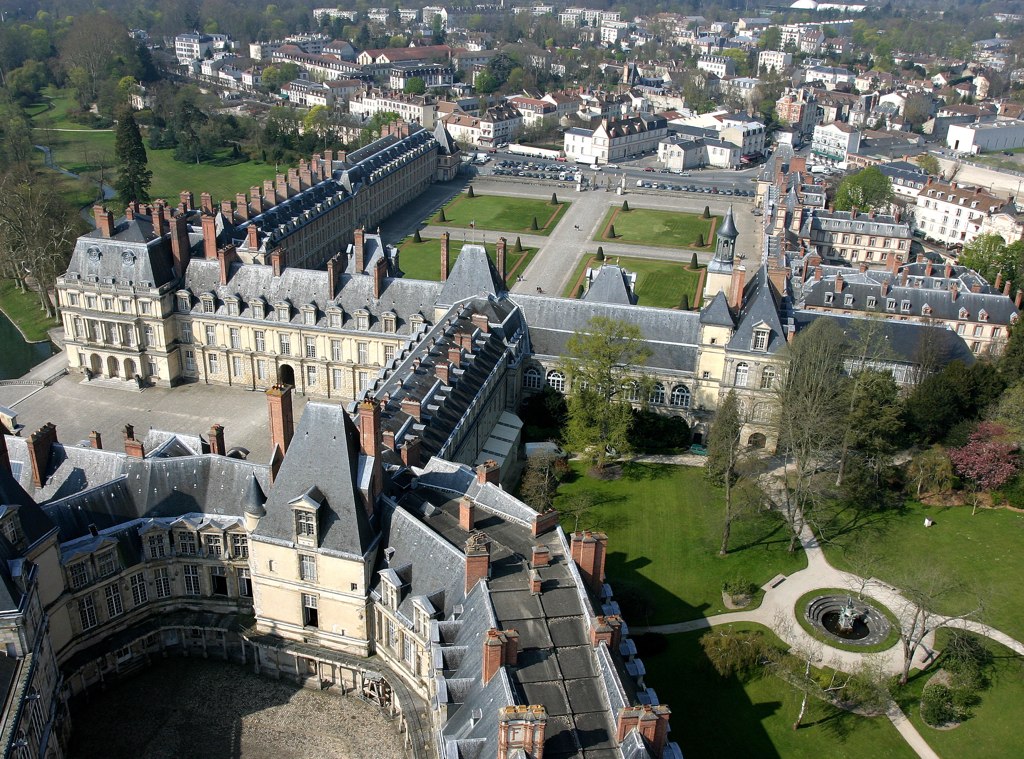
Three) From Amboise to Fontainebleau (but how to get there?)
Hypotheses can be attractive for a number of reasons. Those wanting something particular to be true will tend
to sound as if they have found the truth, even if they have not found nothing more than a hypothesis being attractive
particularly to them. This should be avoided, and sound scholarship should particularly seek to avoid such misuse of
hypotheses.
But in a most positive way hypotheses can help in structuring our thinking. There are ways to hypothetically reconstruct
the early Salvator Mundi history as a journey from Amboise to Fontainebleau. And thus the hypothesis that the Salvator
Mundi was produced for the royal ›trinity‹, helps to find further hypotheses, namely ways, on which the painting
may have passed to Fontainebleau. I am not claiming to have found the truth, but in fact there are possible lineages,
and these lineages are rather simple ones. We see: hypotheses can help also to reduce a potentially unlimited complexity
to a rather small number of simple, but likely possibilities:
One rather simple possibility is that the picture was with Louise of Savoy, and was inherited to either Francis or
Marguerite. Since Louise of Savoy was residing in Fontainebleau with Marguerite at the end of the 1520s, when Marguerite
also gave birth to her daughter Jeanne, the future Jeanne d’Albret (see Freer), it is not far-fetched to think that the
Salvator Mundi might have passed on this rather direct way to Fontainebleau. Not as a picture being very attractive
for a future gallery of Francis I, but as a picture with a very particular (and also problematic) history.
As I said in my last contribution: private devotion and political theology can hardly be divided here, as also can be
seen in one particular episode, when, as a gift for new year’s day of 1544, Francis I had a crucifix sent to his sister,
which was presented to her along with a ballade: ›you command princes and kings‹, Francis wrote, addressing Jesus Christ
in his ballade, and we see how personal devotion and political theology, for the royal ›trinity‹ were actually one
(see Génin, p. 242-244 and 246). We do not encounter historiographical fog here, but the ingredients of microhistory,
the details, and this story can and should be reconstructed as microhistory.
This does not mean that he have to work our way through the age of the French Religious Wars, or that we have to face
the plague at Fontainebleau in 1531, but we can turn historiographical fog into a well-reasoned hypothetical reconstruction,
with actual actors, actual places, and actual events.
If Marguerite once was the owner of the picture, she might have inherited it to Jeanne, the future leader of Calvinists,
and mother of the future king Henry IV. And also on this way, via a detour to the Kingdom of Navarre, the picture might
have passed to Fontainebleau – possibly brought there by the king Henry IV himself. This detour would also be a most
simple and elegant explanation of why, if the picture was produced for the House of Valois, it was only multiplied later,
at the time of Bourbon rule. Jeanne d’Albret, daughter of Marguerite of Navarre and mother of Henri IV, is the link
between the House of Valois and the House of Bourbon. And if above I said that we have also to think of the periphery,
I meant that we could or should also consider places like Pau or Alençon as possibly being part of a Salvator Mundi
geography, and not only most prominent sites such as Amboise and Fontainebleau, in sum: all places to be associated
with Marguerite, Jeanne and last but not least: Henry of Navarre (picture montage of Pau above: Flo641).
The scenery of the upcoming French Wars of Religion is one of the most nightmarish sceneries there are, and in the first
half of the 16th century we find the signs of the times, the signs of tensions, and we find them at Amboise, where in
1534 Protestant propaganda, a placard (after which the Affair of the Placards is named)
was found (aparently posted at the king’s bedchamber door), alerting Francis I, who began to worry for his security.
Since his sister Marguerite sympathized with the Lutheran reformers (her daughter Jeanne would become even more radical),
we also see the tensions between brother and sister upcoming. And it is worth mentioning that the title of the placard
was: «Genuine articles on the horrific, great and unbearable abuses of the papal mass, invented directly contrary
to the Holy Supper of our Lord, sole mediator and sole savior Jesus Christ« (the title in the surviving copy,
shown above and on the right, seems to have been shortened).
The Saviour, as it appears in a Salvator Mundi painting, was not in question. But soon it was asked who the actual
followers of the Saviour were, and who were not.
If the picture’s function would have been solely private devotion, this would not have caused a problem, but if political
theology and, beyond that, religious instruction of princes and princesses (meant to spread the faith via marriages)
came in, the picture, inevitably, was to become part of a nightmarish scenery indeed.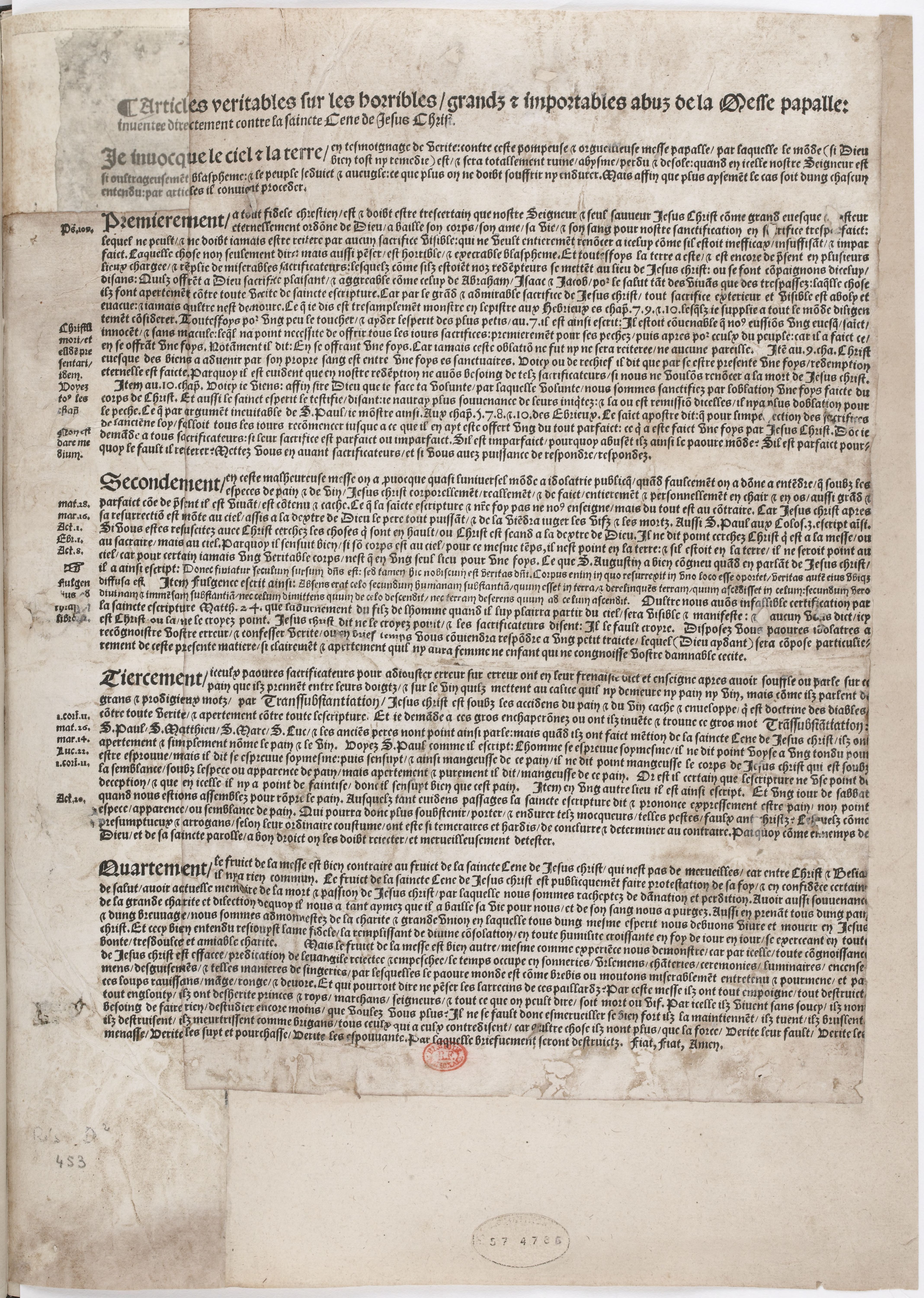
Selected literature:
Robert Jean Knecht, Renaissance Warrior and Patron: The Reign of Francis I, Cambridge/New York 1994
Patricia F. Cholakian / Rouben C. Cholakian, Marguerite de Navarre. Mother of the Renaissance, New York/Chichester 2006
F. Génin (ed.), Nouvelles lettres de la reine de Navarre à son frère le roi François Ier, Paris 1842
Pascal Brioist, Laure Fagnart / Cédric Michon, Louise de Savoie (1476–1531), Tours 2018
Martha Walker Freer, The Life of Jeanne d’Albret, Queen of Navarre, London 1855
Laure Fagnart, The French History of the Pictures of Leonardo da Vinci, online-publication, c. 2013 (yumpu.com)
Laure Fagnart, L’appartement des bains et le cabinet des peintures du château de Fontainebleau sous le règne d’Henri IV,
in: Colette Nativel (ed.), Henri IV: Art et pouvoir, Tours 2016
(picture of Fontainebleau below and above: Nathan Hughes Hamilton)
1516: Paolo Emilio, Italian-born humanist at the court of Francis I, publishes the first four books of his history of the Franks; death of Boltraffio.
1517: Leonardo da Vinci, with Boltraffio and Salaì, has come to France (picture of Clos Lucé: Manfred Heyde); 10.10.2017: Antonio de Beatis at Clos Lucé
1517ff: Age of the Reformation; apocalyptic moods; Marguerite of Navarre, sister of Francis I, will be sympathizing with the reform movement; her daughter Jeanne d’Albret, mother of future king Henry IV, is going to become a Calvinist leader.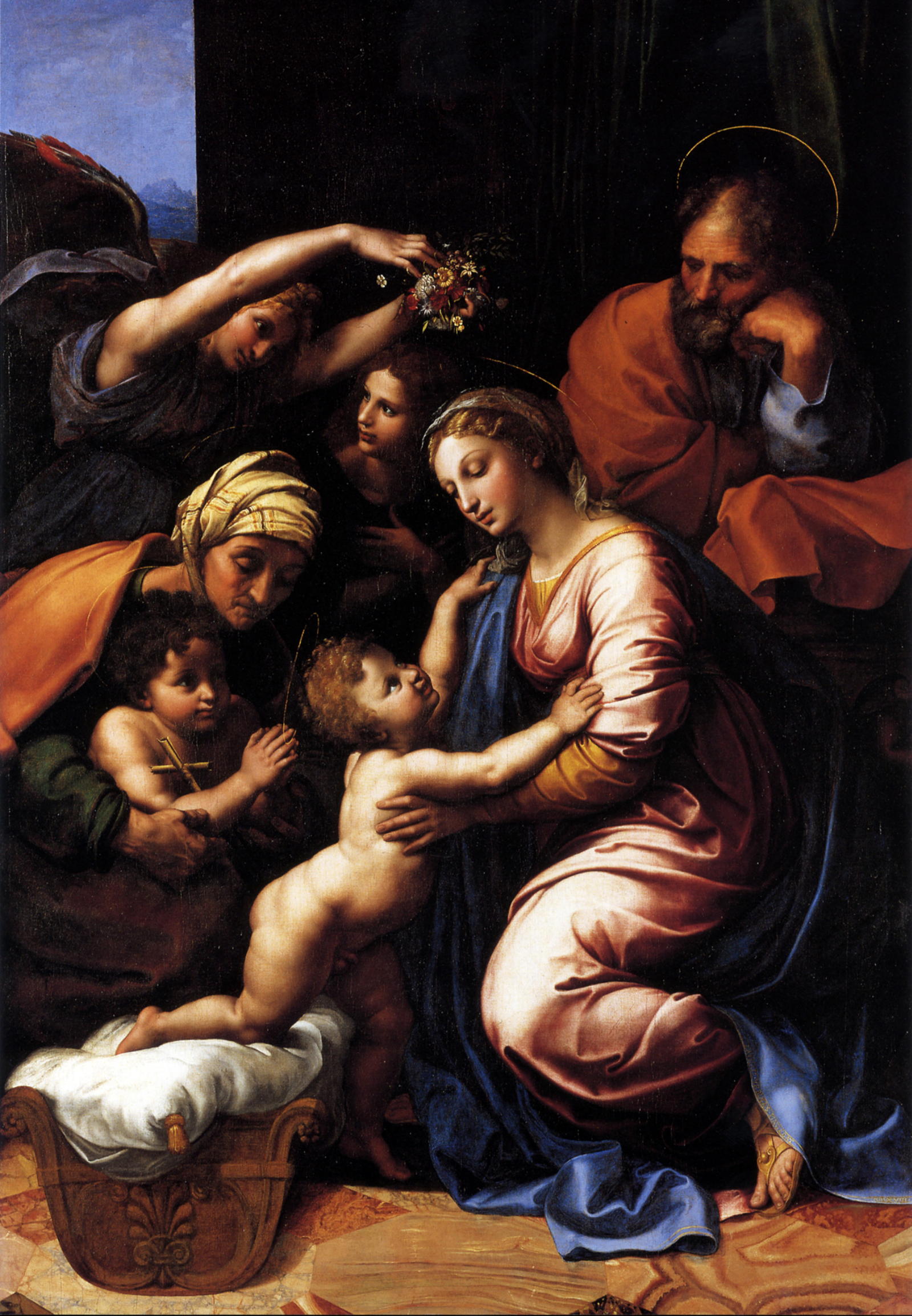
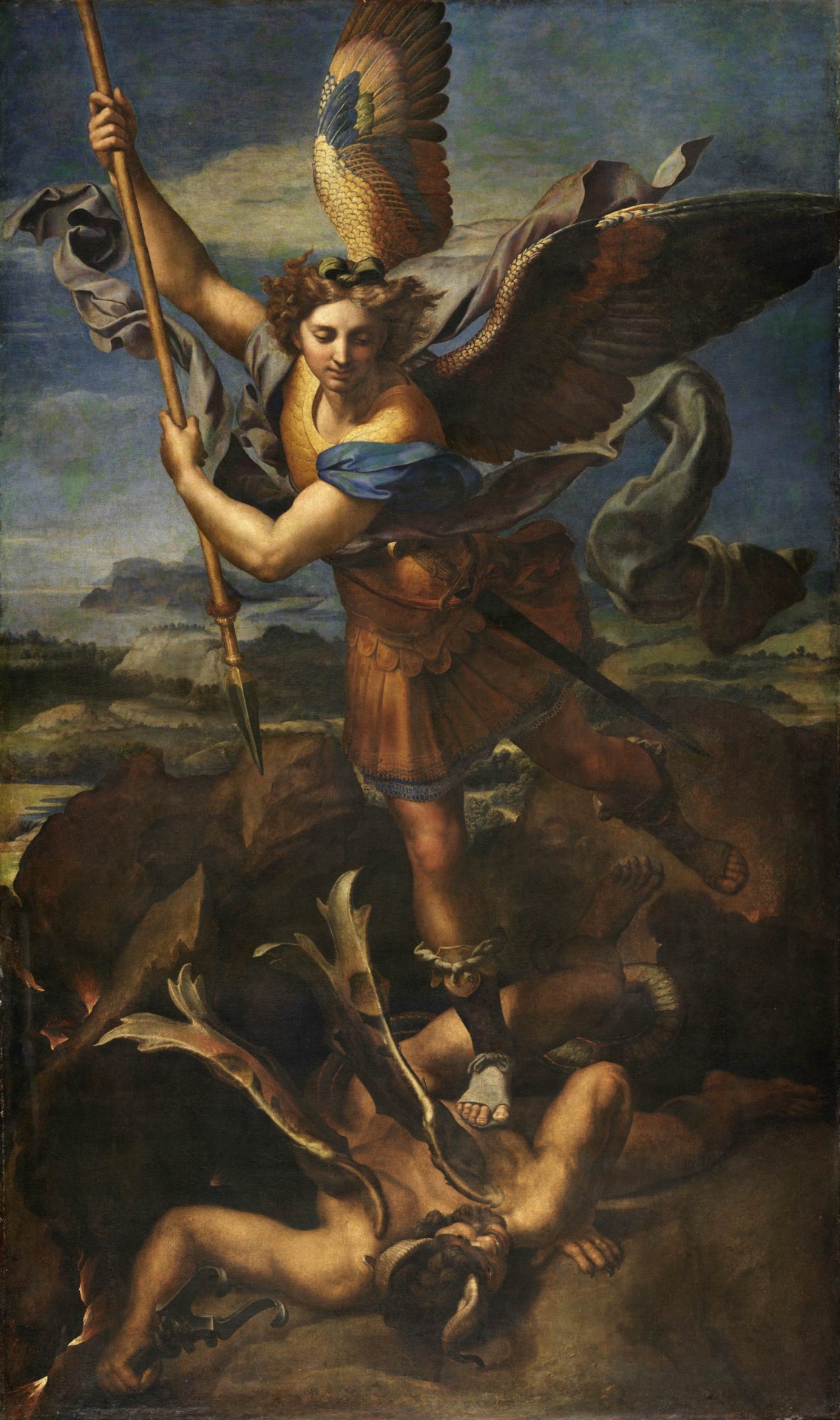
1518: the Raphael workshop produces/chooses paintings to be sent to France; 28.2.: the Dauphin is born; 13.6.: a Milanese document refers to Salaì and the French king Francis I, having been in touch as to a transaction involving very expensive paintings: one does assume that prior to this date Francis I had acquired originals by Leonardo da Vinci; 19.6.: to thank his royal hosts Leonardo organizes a festivity at Clos Lucé.
1519: death of emperor Maximilian I; Paolo Emilio publishes two further books of his history of the Franks; death of Leonardo da Vinci; Francis I is striving for the imperial crown, but in vain; Louise of Savoy comments upon the election of Charles, duke of Burgundy, who thus is becoming emperor Charles V (painting by Rubens).
1521: Francis I, who will be at war with Hapsburg 1526-29, 1536-38 and 1542-44, is virtually bancrupt.
1523: death of Cesare da Sesto.
1524: 19.1.: death of Salaì after a brawl with French soldiers at Milan.
1525: 23./24.2.: desaster of Francis I at Pavia. 21.4.1525: date of a post-mortem inventory of Salaì’s belongings.
1528: Marguerite of Navarre gives birth to Jeanne d’Albret (1528-1572) who, in 1553, will give birth to Henry, future French king Henry IV.
1530: Francis I marries a sister of emperor Charles V.
1531: death of Louise of Savoy; the plague at Fontainebleau.
1534: Affair of the Placards.
1540s: the picture collection of Francis I being arranged at Fontainebleau.
1544: January: Marguerite of Navarre sends a letter of appreciation to her brother, king Francis I., who has sent her a crucifix, accompanied by a ballade, as a new year’s gift.
1547: death of Francis I.
1549: death of Marguerite de Navarre; death of Giampietrino.
1553: Jeanne d’Albret gives birth to Henry, the future French king Henry IV and first Bourbon king after the rule of the House of Valois.
1559: publication of the Heptaméron by Marguerite de Navarre.
1562-1598: French Wars of Religion.
1570: death of Francesco Melzi.
1589: Henry, grandson of Marguerite de Navarre and grand-grandson of Louise of Savoy, but by paternal descent a Bourbon, is becoming French king as Henry IV.
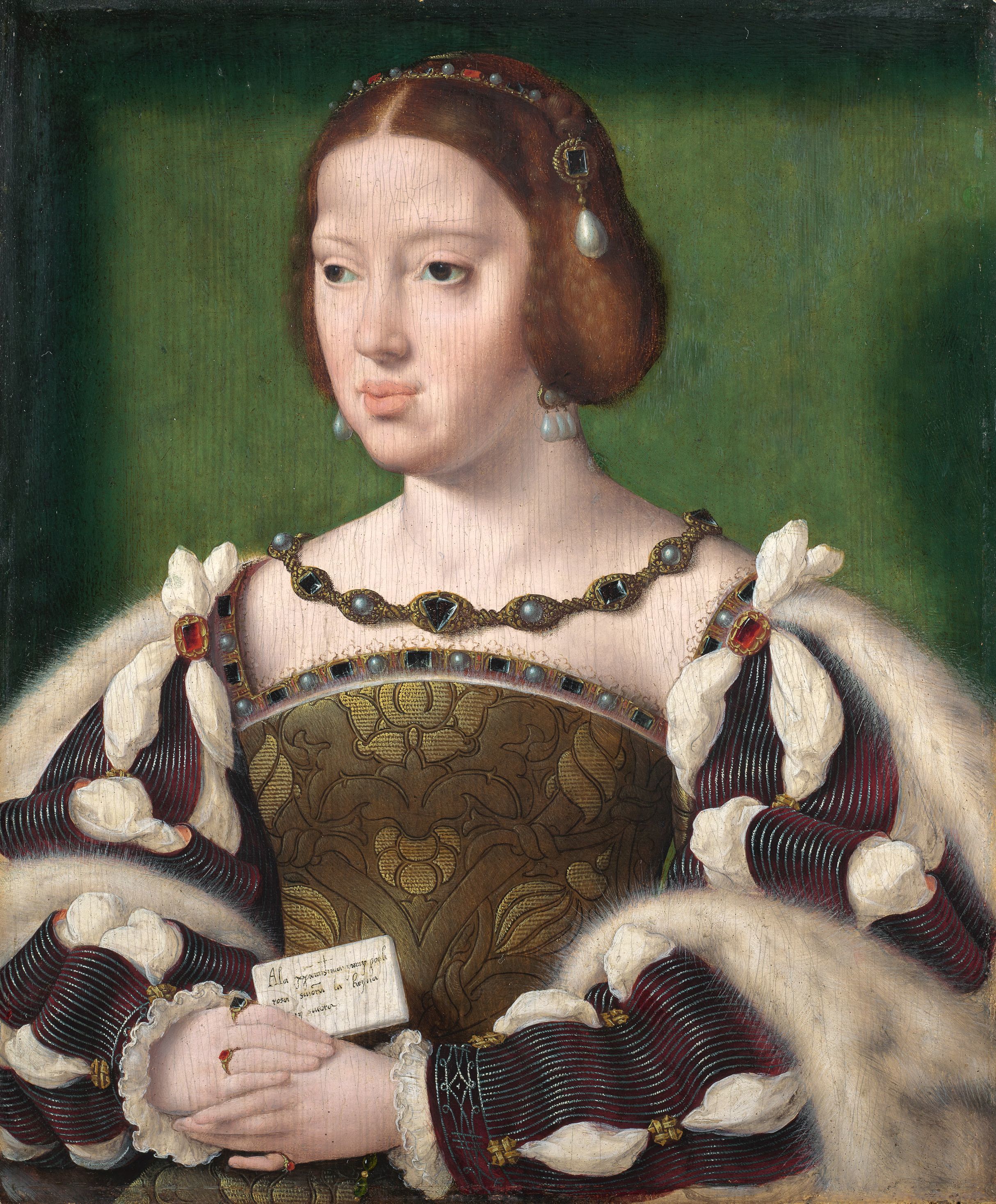
Here we look at two Valois court style portraits, one associated with the workshop of Joos van Cleve, the other with the workshop of Jean Clouet, both court painters of Francis I. We see Eleonore of France, second wife of Francis I, and one of her court ladies, Beatrix Pacheco.
See also the episodes 1 to 3 of our New Salvator Mundi History:
Francis I and the Crown of Charlemagne
And:
MICROSTORY OF ART
ONLINE JOURNAL FOR ART, CONNOISSEURSHIP AND CULTURAL JOURNALISM
HOME
© DS